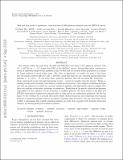Files in this item
Fast and slow paths to quiescence : ages and sizes of 400 quiescent galaxies from the LEGA-C survey
Item metadata
| dc.contributor.author | Wu, Po-Feng | |
| dc.contributor.author | van der Wel, Arjen | |
| dc.contributor.author | Bezanson, Rachel | |
| dc.contributor.author | Gallazzi, Anna | |
| dc.contributor.author | Pacifici, Camilla | |
| dc.contributor.author | Straatman, Caroline M. S. | |
| dc.contributor.author | Barišić, Ivana | |
| dc.contributor.author | Bell, Eric F. | |
| dc.contributor.author | Chauke, Priscilla | |
| dc.contributor.author | van Houdt, Josha | |
| dc.contributor.author | Franx, Marijn | |
| dc.contributor.author | Muzzin, Adam | |
| dc.contributor.author | Sobral, David | |
| dc.contributor.author | Wild, Vivienne | |
| dc.date.accessioned | 2018-09-12T10:30:08Z | |
| dc.date.available | 2018-09-12T10:30:08Z | |
| dc.date.issued | 2018-11-19 | |
| dc.identifier.citation | Wu , P-F , van der Wel , A , Bezanson , R , Gallazzi , A , Pacifici , C , Straatman , C M S , Barišić , I , Bell , E F , Chauke , P , van Houdt , J , Franx , M , Muzzin , A , Sobral , D & Wild , V 2018 , ' Fast and slow paths to quiescence : ages and sizes of 400 quiescent galaxies from the LEGA-C survey ' , Astrophysical Journal , vol. 868 , no. 1 , 37 . https://doi.org/10.3847/1538-4357/aae822 | en |
| dc.identifier.issn | 0004-637X | |
| dc.identifier.other | PURE: 255808908 | |
| dc.identifier.other | PURE UUID: f604dee1-e1ac-489e-8c04-c32763dcc407 | |
| dc.identifier.other | BibCode: 2018arXiv180901211W | |
| dc.identifier.other | Scopus: 85057156178 | |
| dc.identifier.other | WOS: 000450302700002 | |
| dc.identifier.uri | https://hdl.handle.net/10023/16017 | |
| dc.description | Funding: VW acknowledges funding from the ERC (starting grant SEDmorph, PI. Wild) | en |
| dc.description.abstract | We analyze stellar age indicators (Dn4000 and EW(Hδ)) and sizes of 467 quiescent galaxies with M∗≥1010M⊙ at z∼0.7 drawn from DR2 of the LEGA-C survey. Interpreting index variations in terms of equivalent single stellar population age, we find that the median stellar population is younger for larger galaxies at fixed stellar mass. The effect is significant, yet small; the ages of the larger and the smaller subsets differ by only<500 Myr, much less than the age variation among individual galaxies (∼1.5 Gyr). At the same time, quiescent galaxies with the strongest Hδ absorption —those experienced recent and rapid quenching events — tend to be smaller than the average. These co-existing trends unify seemingly contradictory results in the literature; the complex correlations between size and age indicators revealed by our large sample of galaxies with high-quality spectra suggest that there are multiple evolutionary pathways to quiescence. Regardless of the specific physical mechanisms responsible for the cessation of star formation in massive galaxies, the large scatter in Dn4000 and EW(Hδ) immediately implies that galaxies follow a large variety in evolutionary pathways. On the one hand, we see evidence for a process that slowly shuts off star-formation and transforms star-forming galaxies to quiescent galaxies without necessarily changing their structures. On the other hand, there is likely a mechanism that rapidly quenches galaxies, an event that coincides with dramatic structural changes, producing small post-starburst galaxies. | |
| dc.language.iso | eng | |
| dc.relation.ispartof | Astrophysical Journal | en |
| dc.rights | Copyright © 2018, American Astronomical Society. This work has been made available online in accordance with the publisher’s policies. This is the author created accepted version manuscript following peer review and as such may differ slightly from the final published version. The final published version of this work is available at https://doi.org/10.3847/1538-4357/aae822 | en |
| dc.subject | Galaxies: evolution | en |
| dc.subject | Galaxies: formation | en |
| dc.subject | Galaxies: high-redshift | en |
| dc.subject | Galaxies: stellar content | en |
| dc.subject | Galaxies: structure | en |
| dc.subject | QB Astronomy | en |
| dc.subject | QC Physics | en |
| dc.subject | 3rd-NDAS | en |
| dc.subject.lcc | QB | en |
| dc.subject.lcc | QC | en |
| dc.title | Fast and slow paths to quiescence : ages and sizes of 400 quiescent galaxies from the LEGA-C survey | en |
| dc.type | Journal article | en |
| dc.contributor.sponsor | European Research Council | en |
| dc.description.version | Postprint | en |
| dc.contributor.institution | University of St Andrews. School of Physics and Astronomy | en |
| dc.identifier.doi | https://doi.org/10.3847/1538-4357/aae822 | |
| dc.description.status | Peer reviewed | en |
| dc.identifier.url | http://adsabs.harvard.edu/abs/2018arXiv180901211W | en |
| dc.identifier.grantnumber | ERC-2012-StG-20111012 | en |
This item appears in the following Collection(s)
Items in the St Andrews Research Repository are protected by copyright, with all rights reserved, unless otherwise indicated.

